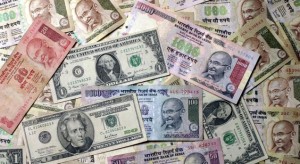Liberalization of trade has witnessed steep fall in Indian rupee, which has already touched the all time low of 65 against US dollar. From skepticism about the RBI (Reserve Bank of India) policies to failure of Indian Government in containing the liquidity, investors are blaming this sell-off on anything and everything on their way. Not only India, but also fellow developing economies like Brazil, Turkey, Russia, Indonesia and South Africa are also suffering from the similar problem. Despite the fact that India is not the only country to struggle with weakening currency, 15% fall within the timeframe of three months is unique for the country in many ways. Finding out why the rupee is falling becomes essential as far as market research in finance sector is concerned.
Why is Indian Rupee Falling Against Dollar and Pound?
As of now, rupee has stooped to 65 against US dollar, while 101 against pound. Consecutive free fall of rupee triggered index stocks selling and pessimistic financial moves from Indian investors spread across different parts of the world. The factors responsible for this fall have not surfaced overnight but they have been building up over a large time span. High inflation rate, rising current account deficit and fluctuating policies by the Reserve Bank of India are but some of the obvious reasons that triggered this situation.
Inflation: Rise in the rate of inflation is directly proportional to rise in the prices of consumer goods. Currency of the country has to hold its grounds against dollar by adjusting to the changing inflation rate. However, this is not the case with the rupee, which is failing to maintain the said balance. Inflation creates major issues as far as currency exchange is concerned, which leaves deficits that are hard to fill.
Investments: Foreign Institutional Investors (FIIs) and Foreign Direct Investments (FDIs) have direct impact on national currency. Both these factors promote smooth sail of dollar in the country. The increased flow of dollar is a great sign in terms of appreciation of rupee. It is also the reason why Indian rupee witnessed appreciation during 2002 investment reforms.
Trade Position: This is third and the most important reason behind the epic fall of Indian rupee. Balance of the trade position in India is a critical aspect for any developing economy. In terms of Indian economy, international trade defines the position of the country on global business horizon. It shows the demand for rupee on global platform. Indian trade relies on the demand for dollar and other foreign currencies to boost trades. Increased demand for dollar clearly means least requirement of rupee.
How will Falling Rupee Affect the Indian Common Man?
According to the expert economists in the country, middle class Indian will greatly suffer from this whole rupee depreciation crisis. Whether the rupee will return to a stable level is currently in the dark, which is feared to create more troubles in the lives of customers in India. Importers will be the biggest victims of this crisis. These people will be forced to spend more money for importing goods from around the world. Thus, prices of imported goods, fuels and tourism will struggle. Other people to be struggling with falling rupee are the students studying abroad, who will have to endure the most with extra education fees.
Falling rupee will raise inflation rate further, which will reduce the policy rates regularized by RBI. This will affect the loan regimes and policy durations and add to the borrower’s woes. Exporters and NRIs will be the only people at the positive end of this whole situation. Rising dollar is a positive sign for the overseas Indians will earn more in the form of remitted money. Exporters on the other hand will gain more money with competitive prices for Indian products in global markets. According to global market research experts, weaker rupee will be a fruitful prospect for the export industry in India.
Role of Indian Authorities in Rupee’s Free Fall against Dollar
Both Reserve Bank of India and Indian Government have been intervening into the dismal condition of the national currency from time to time. After the historic fall of Indian rupee to 65.56 against dollar, the lawmakers are expected to adopt emergency reforms to stop further downfall. The basic focus of the government is at reducing trade deficit and pushing the investment boundaries farther. Both these steps will be taken in a hope to promote investments in different sectors.
The major reforms also include restrictions on outbound investments, gold imports and creating an investor-friendly foreign direct investment policy. Government has already announced FDI reforms in different business sectors including telecom, retail, aviation and defense. The biggest hurdle to their success are said to be bureaucratic red tape and regional political troubles. Overcoming these two hurdles is essential to conquer this historic crisis.
Indian government is currently making all the possible efforts to pass two measures. These two reforms include easy acquisition of business lands and up to 49% of foreign direct investments in the pension sector. Conquering the trade imbalance is also going to be a major challenge for the nation. Apart from United States of America, India has disturbed trade balance with most of its trade partners. It means a trade deficit with round about 80 countries.
RBI has always been cautious about its timely interventions into the financial scenario of India. The entire rupee depreciation crisis is also said to be triggered by certain fluctuating reforms from this central bank of the country. However, as far as the official steps are concerned, the bank is making efforts in increasing stem market liquidity and short-term investments. The bank is also made stringent rules for banks that are into exchange traders-currency derivatives separate from RBI.
All these reforms are expected to regain the confidence from the investors. However, looking at the current crisis, the situation is expected to last longer than expected. However, increased FDIs, FII inflows and regained European and Greek economies will definitely bring stability in the Indian economy.




